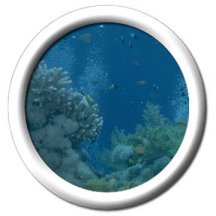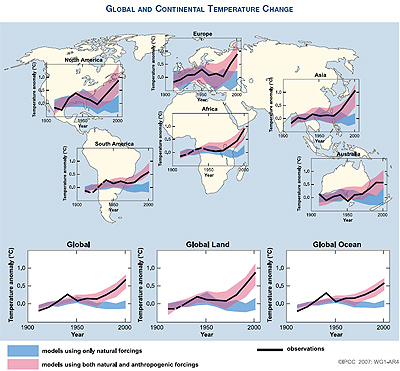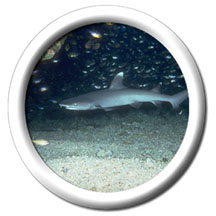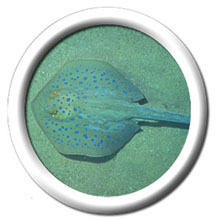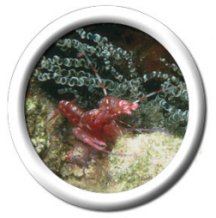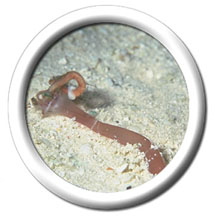Reefs in Hot Water: Coral Bleaching and Climate Change
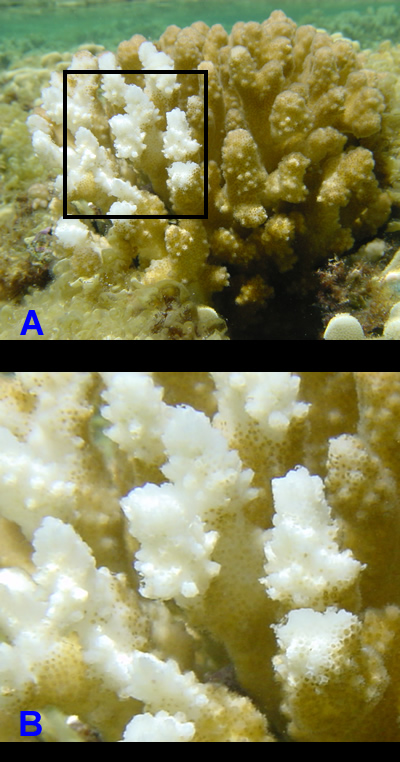 |
Partially bleached coral colony (Pocillipora sp.) on a Pacific reef (A) and close up view of bleached area (B). |
Many factors threaten reef health. One of the largest threats is warmer ocean water. Warmer ocean water stresses coral colonies, which form the framework of tropical reefs. This weakens the corals through a process called coral bleaching.
According to the Fourth Assessment Report of the Intergovernmental Panel on Climate Change, as tropical waters continue to warm, coral reefs will bleach more often than they can handle. Bleaching events have already had a large impact on many reefs and will likely become more frequent in the future. This will reduce coral cover and diversity on reefs over the next few decades.
What is coral bleaching?
Coral colonies are made up of hundreds or even thousands of individual coral animals. Each coral animal has algae living within its tissues. The algae, called zooxanthellae, photosynthesize - making the food they need with help from the Sun’s energy. The algae produce more food than they need and the corals supplement their diets with the leftovers.
This is an example of symbiosis between two types of living things. The corals offer the algae a nice place to live. The algae offer food for the corals. There are some species of coral that do not have this symbiosis, but most of the ones that are able to build reefs do have symbionts. It is beneficial to both the corals and the algae.
However, during times of environmental stress, the coral animals will release the algae from their tissues. This is called coral bleaching. The coral animals are left transparent in color without the colorful algae in their tissues, so their white skeletons show through. This makes a bleached coral appear white in color.
Why do corals bleach?
Corals bleach for a number of different reasons and scientists are actively studying coral bleaching to better understand what causes it. However, one of the main causes of coral bleaching is the presence of unusually warm seawater. Since corals are very sensitive to changes in temperature, warming of only 1 degree Celsius can cause corals to bleach. Since the oceans are warming as climate continues to change, the amount of bleached corals is expected to become more pronounced. Plus, the part of the ocean that warms the most is the sea surface and most reef corals live quite near the sea surface.
There are other reasons that corals bleach too. Corals may bleach if salinity changes, if there are high levels of solar radiation (typically during summertime), if the reef is in the path of a large storm, if there is pollution in the water, or if sediment runoff from land makes its way to the reef. While bleaching is a natural reaction, it has become more common as human impacts on the ocean have grown.
Some species of coral are more susceptible to bleaching than others. In general, coral species that form branching, tree-like colonies are more susceptible to bleaching than coral species that form round, boulder-like colonies. Some species of the symbiotic algae are more sensitive to environmental stress too.
What happens to the bleached coral?
Bleaching weakens the coral animals. Many of the corals that bleach will not recover. Without the algae in their tissues, the bleached corals have much less nutrition. They are able to catch and eat plankton, but this is not as much food as they are used to having. If the stressful environmental conditions end, corals can take more algae into their tissues and regain their health. If the stressful conditions continue, the corals are likely to die.
Thousands of other organisms call coral reefs home too – from large sharks and rays to tiny shrimp and worms. If most of the corals on a reef bleach (in what is called a “mass-bleaching event”) and then die, this can impact the survival of many other creatures that rely on the reef - either directly on corals as a source of food or indirectly on the reef structure for habitat.
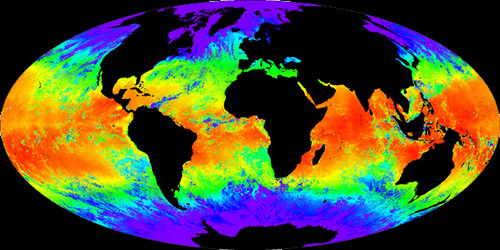 |
On this map, red indicates warmer sea surface temperatures, yellow and green are intermediate, and blue indicates cold water.Coral reefs thrive in the tropics, in the red band. However as sea surface temperatures warm due to climate change, the waters can become too warm for corals. (This map was produced using MODIS data acquired daily over the whole globe.) |
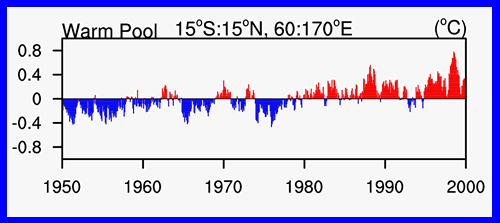 |
Monthly sea surface temperature (SST) anomaliesin degrees Celcius over the equatorial Indian and western Pacific Oceans (lower left) from 1950 to 2000. |
The above, written by Lisa Gardiner, was designed for Understanding Climate Change Today, an online course for educators. Please visit NCAR Online Education for more information about this and other courses.





